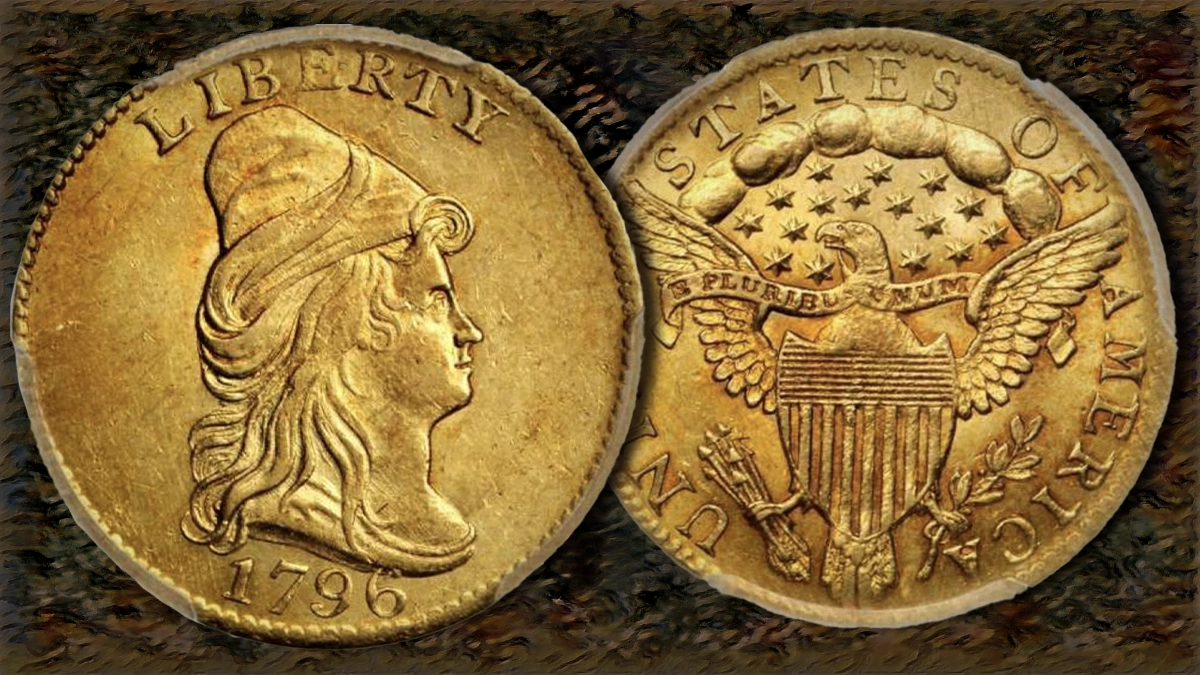
There is little doubt that the 1796 Capped Bust Right, No Stars quarter eagle and the 1808 Capped Bust quarter eagle are two of the most important type coins in the entire panorama of American numismatics.
After Congress passed the Mint Act of April 2, 1792, steps were taken to construct a Mint facility in Philadelphia, then the nation’s capital. The cornerstone for the new building, the first structure built by the United States Federal Government, was placed on July 31, 1792, and construction continued through early 1793.
The first coins struck at the new money factory was the 1793 Chain cent, with 11,178 coins delivered on March 1 of that year. These were of the famous AMERI. variety.
While the Mint Act authorized the production of gold and silver coins, the Mint was held up in producing these coins because of the bond requirements set by Congress. By law, the Mint’s treasurer, assayer, and chief coiner were required to post a $10,000 bond to ensure the proper handling of gold and silver deposits. Given that the annual salary for the assayer and chief coiner in 1795 was $1,200, this was an unreasonable sum of money for blue collar workers to come up with.
Recognizing this, Congress lowered the bond requirement to $5,000, and once the bonds were posted, the Mint was able to start production of gold and silver coins. The first silver coins were struck in 1794. The first gold coins were struck in 1795.
The Mint Act proscribed that silver coins would be denominated in dollars and gold coins would be denominated in eagles. The eagle was a large gold coin worth $10 dollars. The quarter eagle denomination, therefore, was subsidiary to the eagle, and was assigned a value of $2.50.
The first quarter eagles were struck in September and delivered to by the coiner on September 21, 1796. The total number of coins delivered was just 66 pieces. This rare variety is known as BD-1 (BD for Bass-Dannreuther).
Numismatists believe that coinage of the denomination was suspended at this point due to the failure of the reverse die. With no replacement dies on hand, the second delivery of 1796 Capped Bust quarter eagles did not take place until December 8, 1796. 897 pieces were included in this delivery, all from one die marriage, which numismatists refer to as BD-2. While BD-1 and BD-2 varieties were struck from different obverse dies, both are of the No Stars type.
A third delivery of 432 1796-dated coins took place on January 14, 1797. These were all of the BD-3 variety and feature 16 stars on the coin’s obverse.
Today, there are six known examples of BD-1, approximately 80 to 100 examples of BD-2, and 40 to 50 examples of BD-3. Each of these current estimated populations represent about 10% of the proposed original mintage.
| Deliveries of 1796 Capped Bust Right Quarter Eagles | |||
| September 21, 1796 | 66 delivered | December 8, 1796 | 897 delivered |
| January 14, 1797 | 432 delivered | Total: 1,395 coins | |
Understanding Key Coin Concepts : Coin Delivery
For those who are not well versed in numismatic terminology, a few words of explanation of the term “delivery” or “delivery date”.
In the early years of the United States Mint, individuals (persons or firms) deposited their silver or gold at the Mint where it was received by the Mint treasurer. After being refined by the assayer to the proper purity, the deposit would be received by the chief coiner for production into actual coins. These coins would then be delivered back to the Mint treasurer with an associated document known as a “delivery warrant” with a specific quantity of coins produced and the date that they were received by the treasurer. It was these dated “delivery warrants” that now give us the term “delivery” or “delivery date.”
These delivery dates have proven helpful to numismatists in determining die emission sequences, but a certain amount of ambiguity remains when it comes to actual mintages.
1796 Capped Bust Right Quarter Eagle, No Stars
All known 1796 Capped Bust Right Quarter Eagles were struck with the heraldic eagle (also known as the large eagle) reverse. The first two die marriages of feature the no stars obverse. On the third die marriage, 16 stars were placed around the design, eight on each side of LIBERTY.
It’s interesting to note that in 1860, Mint Director James Ross Snowden remarked in his Description of Ancient and Modern Coins, in the Cabinet Collection at the Mint of the United States Snowden, that the first issue, “which was made on the twenty first of September, was of the same type as the eagle.” The reverse of 1796 Capped Bust Eagle features the so-called “small eagle” reverse.
No known examples of the quarter eagle were struck with this design. As the With Stars BD-3 variety is known to have been struck after the No Stars BD-2 variety, with which it shares a common reverse, one can only assume that Snowden’s information in this case was faulty.
The hubs of the 1796 Capped Bust Right Quarter Eagle are believed to have been executed by John Smith Gardner (although R.W. Julian believes Gardner was hired to carry out mundane tasks). The “Gardner” reverse hubs feature an eagle with a longer neck, visible tongue, two rows of tail feathers, and three claws.
* * *
Market Data and Noteworthy Specimens
1796 Capped Bust Right Quarter Eagle, No Stars. BD-1.
Rarity-9. No Stars Date straight. L apart, I low, BE with spacing, RTY together. Reverse: 16 stars above eagle in 7-7-1-1 formation. On the top row of stars, stars 2,3, and 4 touch clouds. Likely struck and delivered on September 21, 1796. Estimated 66 pieces struck. Reverse die failure cut service life short. Four known today.
1796 Capped Bust Right Quarter Eagle, No Stars. BD-2.
Top Population: PCGS MS-65 (1, 2/2024). NGC MS-65 (1, 2/2024). CAC MS-65 (1:0 stickered:graded, 2/2024).
Adams-1; Clapp-1; Newcomer-672. Rarity-4. Same obverse as BD-1 with no reverse. No Stars Date straight. L apart, I low, BE with spacing, RTY together. Reverse: 16 stars above eagle in 7-7-1-1 formation. Top row of stars does not touch clouds. Softness on center at eagle is fairly typical, due to the height of the relief on the obverse. In late die state, die cracks come down from the center of LIBERTY into the cap. Another on the right side of the E of LIBERTY to Liberty’s front hair curl. 963 believed struck of this variety. Scarce in mint state. Perhaps 100 to 130 known.
- PCGS MS-65 #5324089: As PCGS MS-65 #5324089. Lorin Parmelee; “The Lorin Parmelee Collection,” New York Coin and Stamp Company, June 1890, Lot 790 – $18; Colonel Robert C.H. Brock; Philip H. Ward, Jr.; “The Philip H. Ward, Jr. Collection,” Stack’s, May 1964, Lot 1660 – $7,750; University of Pennsylvania; Lelan Rogers; Stack’s, November 1995, Lot 1498 – $605,000; “A Gentleman’s Collection,” American Numismatic Rarities, June 2005, Lot 1002 – $1,380,000; “The Madison Collection,” Heritage Auctions, January 10, 2008, Lot 3058 – $1,725,000.
- PCGS MS-63 #46092642: Abner Kreisberg; Harry W. Bass, Jr.; Harry W. Bass, Jr. Foundation Collection. As PCGS MS-63 #46092642. “The Harry W. Bass, Jr. Core Collection, Part II,” Heritage Auctions, January 5, 2023, Lot 9003 – $990,000. Gold Harry W. Bass, Jr. Collection novelty insert.
- NGC MS-63 #1891964-001: Heritage Auctions, January 2004, Lot 3004 – $138,000; marketed by Mike Byers in February 2012 for $750,000; Heritage Auctions, August 2012, Lot 5281 – $252,625; “The Warshaw Family Collection”, Heritage Auctions, January 9, 2020, Lot 4325 – $300,000. Pedigree research assisted by Heritage Auctions.
- NGC MS-63 #1776966-004: Superior, March 2000, Lot 712 – $178,250; Heritage Auctions, January 4, 2007, Lot 3380 – $287,500. FREEDOM COLLECTION on insert.
- PCGS MS-62+ CAC #44161395: James Swan; Oliver Jung. As PCGS MS-62. “The Oliver Jung Collection”, American Numismatic Rarities, July 2004, Lot 82 – $345,000; “The Samuel J. Berngard Collection,” Stack’s, July 2008, Lot 2324 – $488,750; Bob R. Simpson. As PCGS MS-62+ CAC #44161395. “Important Selections from the Bob R. Simpson Collection, Part VII”, Heritage Auctions, January 13, 2022, Lot 3780 – $2,160,000. Bob Simpson novelty insert. Upgraded one half point.
- PCGS MS-62 #21774133: Kevin Lipton; Bayfield Collection, January 2007; “The Bayfield Collection,” Heritage Auctions, November 16, 2023, Lot 3119 – $492,000.
- PCGS MS-62 #03332336: Harold P. Newlin; Newlin to T. Harrison Garrett, by sale, October 31, 1884; T. Harrison to Robert and John Work Garrett, by descent, 1888; Robert Garrett interest to John Work Garrett, 1919; John Work Garret, outright, 1921; Garrett to Johns Hopkins University, by gift, 1942; “The Garrett Collection, Part II,” Bowers and Ruddy, March 1980, Lot 732 – $125,000; Ed Hipps to John Whitney Walter, by sale, “The John Whitney Walter “Mr. 1796″ Collection of the Coins of 1796”, Stack’s, May 1999, Lot 1787. As PCGS MS-62 #03332336. “The D. Brent Pogue Family Collection, Part I,” Stack’s Bowers / Sotheby’s, May 2015, Lot 1116 – $822,500. D. Brent Pogue novelty insert. Pedigree research by Stack’s Bowers.
- NGC MS-62 #6066356-001: “The Paramount Collection,” Heritage Auctions, February 24, 2021, Lot 3735 – $276,000. Paramount Collection novelty insert. Prominent adjustment marks on obverse and reverse. Curved march below the chin.
- NGC MS-62: American Numismatic Rarities, March 21, 2012, Lot 4258 – $258,750.
- PCGS MS-61 CAC #13582143: Heritage Auctions, August 2011, Lot 7436 – $276,000; “An Important New York Collection,” Heritage Auctions, June 14, 2018, Lot 4094 – $396,000.
- PCGS MS-61 CAC #12766377: Stuart Levine; Stuart Levine sold to Ed Price, August 2001; “The Ed Price Collection,” Heritage Auctions, July 21, 2008, Lot 1451 – $276,000. Small gouge near drapery at bust.
- NGC MS-61 #916122-004: Heritage Auctions, January 4, 2007, Lot 3379 – $253,000.
- PCGS MS-61 #4760717: John Story Jenks; “The John Story Jenks Collection”, Henry Chapman, December 1921, Lot 5784 – $140; “The James A. Stack, Sr. Collection”, Stack’s, October 1994, Lot 829 – $82,500. As PCGS MS-61 #4760717. “The Alpine Zephyr Collection,” Heritage Auctions, August 14, 2006, Lot 5417 – $322,000. As MS61 CAC Gold. “The Werner Family Collection of 1796 Coinage”, Stack’s, August 2012, Lot 11174 – $411,250. Russ Augustin (AU Capital Management) to Martin Logies, The Cardinal Collection Educational Foundation, November 19, 2013 – $425,000. As PCGS MS-61 Gold CAC #4760717. “The Cardinal Collection,” Stack’s Bowers, October 2015, Lot 55 – $352,500; “earlyAurum” PCGS Set Registry.
Additional CoinWeek Coverage of the 1796 No Stars Quarter Eagle
Coin expert Greg Reynolds shares his thoughts on the results of the first of five auctions of the coins from the historic D. Brent Pogue Family Collection. Among the many highlights of the May 2015 sale is the Newlin-Garrett-Pogue 1796 No Stars quarter eagle.
Gold coin expert Doug Winter breaks down the winners and losers from the Pogue family’s impressive collection of early U.S. quarter eagles from the Pogue I sale.

In this article, Doug Winter discusses ten of the most important U.S. gold coin rarities and what sets them a cut above of the rest. The 1796 No Stars quarter eagle ranks high on Doug’s list.
Design
Obverse:
Right-facing portraits of Liberty. Liberty is wearing a Phrygian cap. LIBERTY appears at the top of the design. The date appears below. A dentilled border wraps around the coin at the rim.
Reverse:
On the reverse is a Heraldic Eagle design that was adapted from the Great Seal of the United States. A shield covers the eagle’s breast and a row of clouds and a constellation of 16 stars, called a glory, is positioned above the eagle’s head and outstretched wings. The legend UNITED STATES OF AMERICA follows the border, and the eagle holds an olive branch and eight (more or less) arrows in its claws. A dentilled border wraps around the coin at the rim.
Edge:
The edge of the 1796 1796 No Stars Capped Bust Right Quarter Eagle is reeded. Reeding was and still is used as an anti-counterfeiting measure by mints around the world.
* * *
Coin Specifications
| Country: | United States of America |
| Year Of Issue: | 1796 |
| Denomination: | Two Dollars and Fifty Cents (USD) |
| Mint Mark: | None (Philadelphia) |
| Mintage: | 963 |
| Alloy: | .917 Gold, .083 Copper |
| Weight: | ±4.37 g |
| Diameter: | ±20 mm |
| Edge | Reeded |
| OBV Designer | Robert Scot |
| REV Designer | Robert Scot |
| Quality: | Business Strike |
* * *




